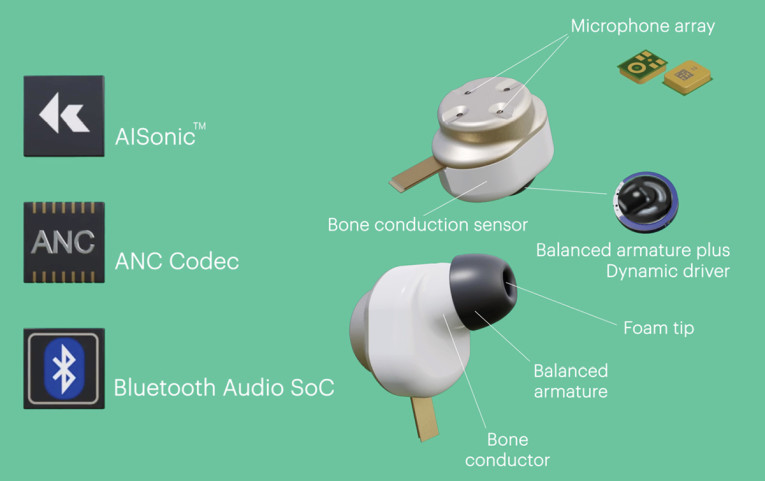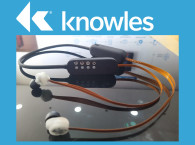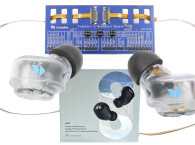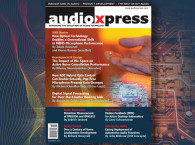
New use cases for TWS headphones (e.g., voice calling with advanced noise suppression features, HD audio streaming, adaptive active noise cancellation, and hearing or conversation enhancement) will all continue to accelerate the demand from consumers. As OEMs race to develop their own versions of in-demand TWS designs, product differentiation is the key to ensuring their piece of the market share.
To empower OEMs, the creators of these sought-after devices, Knowles recently created a configurable powerful TWS development kit that provides them access to fully operational TWS design. Enhanced with the most advanced features and functionality available today, the kit comes with pre-tuned earbud configurations equipped with Knowles’ SiSonic MEMS microphones, voice vibration sensors for high-quality audio capture, and a hybrid or full range balanced armature speaker driver assemblies that can support high-resolution audio specifications.
Here, we’ll dive into some of the specifications of the kit—the technical must-haves for OEMs continuing to ride the wave of TWS growth. This article will also explore how an advanced TWS development kit loaded with computational horsepower and features can drive the path to success in the TWS market.
The Competitive Edge: What’s Under the Hood
The processing platform at the core of the Knowles TWS Development Kit is based on the IA8201 AISonic audio edge processor, Sony Semiconductor Corp.’s CXD3781 codec, and Qualcomm’s 5141 premium Bluetooth SoC chipset.
The IA8201 processor provides audio fidelity and machine-learning optimization, allowing manufacturers to deliver a competitive edge for high-quality audio communication devices and other advanced AI features. It brings the advantage of high-compute efficiency and low-power operation for voice activation, hands-free control, and contextual audio processing. It also features a rich set of audio and general-purpose high-speed interfaces to enable flexible performance with digital microphones and other sensors. And crucially, the open DSP available on the IA8201 audio edge processor provides a rich, scalable platform for customer or third-party solutions.
The IA8201 is also a great choice for TWS manufacturers looking to quickly add third-party algorithms and AI-based voice or audio features with a short time-to-market requirement. The Knowles TWS kit comes with several third-party algorithms pre-integrated and optimized on IA8201 that deliver high-performance and differentiation.
What Listeners Want to Hear: Driver Optimization for ANC, Output, and More
The TWS marketing and consumer preferences are trending toward premium audio. More consumers are demanding hardware that offers studio-quality audio output for enjoying their favorite music. Since Bluetooth and Cloud connectivity has made massive improvements since the MP3 era, HD or lossless quality audio can now be directly streamed to TWS devices. In addition, advancements in digital signal processing (DSP) and driver technologies means TWS devices can support high-fidelity music while also featuring state-of-the-art ANC and transparency features. The combination of advanced features offers a fresh listening experience, even for seasoned enthusiasts, making it necessary for OEMs to embrace this philosophy in the product development process.
Balanced armatures (BAs), developed originally for hearing aids and critical listening applications, offer improved fidelity and detail that remain unmatched by traditional dynamic drivers. Where dynamic drivers operate with a moving coil, BA drivers use a stationary coil that vibrates a reed balanced between two magnets inside a small enclosure. The lighter mass of the moving parts results in exceptional clarity, especially in the treble. Its lightweight and compact footprint also saves space for additional components, such as additional drivers for hybrid applications or for bigger batteries.
BA drivers may also be combined with traditional dynamic drivers in a hybrid system. In these systems, the dynamic speaker handles the lower frequencies, while the BA driver(s) reproduce the critical highs. The Knowles TWS Reference Design Kit offers manufacturers two versions of earbuds to embrace this key benefit—one with a full-range BA and the other with a hybrid driver, with a BA tweeter and dynamic driver woofer. Both earbuds have three digital microphones with high signal-to-noise ratio (SNR), low distortion, low latency, and a flat frequency response to ensure premium performance.

Recent industry research from FutureSource confirms that conversation enhancement through hearing augmentation is highly sought-after by 61% of TWS earbud users. Paralleling the hearing aid industry to improve sound perception, hearing enhancement enables users to enjoy more vivid conversation, used with or without ANC depending on the environment. When applied to TWS use cases, a booster algorithm removes disruptive background noise including music, reverb, and surrounding conversation for clean sound processing, reducing the listening effort for users.
The Knowles TWS Development Kit includes AITransparency+, a feature from Knowles partner Chatable—the first AI specifically designed to exploit the next-generation AI processing capabilities of the IA8201 AISonic processor for “Conversation Enhancement.” AITransparency+ provides “Conversation Enhancement” and features advanced, on-chip, proprietary deep neural network architectures performing more than 100 million AI calculations per second to enable selective acoustic enhancement of conversational speech signals without perceptible latency.

Getting by with a Little Help from Friends: Personalization for TWS Development
Designing an advanced TWS kit takes a broad range of technologies from multiple domains. This is why the Knowles development kit has been developed in partnership with several algorithm vendors to bring a breadth of advanced features and shorten the design and market cycle for OEMs that want to deliver emerging use cases. With existing integrations from Sony, Chatable, Alango, and Sensory, the Knowles TWS kit already has the most advanced algorithms for TWS devices today.
Combined with proprietary technology, Sony Semiconductor’s CXD 3781 codec is included in the design to provide integrated hybrid noise cancelling and transparency. This works in tandem with a QCC 5141 Bluetooth Audio SoC which, along with premium BAs, deliver high-resolution audio.
To enhance voice quality and intelligibility, the kit is also supported by an advanced voice communication package from Alango Technologies, which offers multi-microphone beamforming, and its OnlyVoice technology, which intelligently combines external beamforming with internal sensor-based voice processing ported to the IA8201 processor.
With low power consumption and memory requirements, these highly optimized solutions enable premium voice pickup for TWS devices. By combining Sensory’s wake word technology with the Knowles’ IA8201 audio edge processor, manufacturers can achieve high-performance, embedded voice solutions.
The inclusion of technologies from these partners in the Knowles TWS kit enables OEMs to benefit from established technologies, while also including their own third-party or proprietary features in their designs. The integration of the most in-demand features will allow for a competitive edge, with the opportunity to continue to build and modify based on the manufacturer’s expertise.

Conclusion
The TWS development kit from Knowles builds bridges for TWS developers: It grants access to the most in-demand features for forward innovation, supported by premium Knowles components and state-of-the-art partner technologies. It also allows more partners to join in on the growth with an accessible option for product development. Offering the foundation for TWS technology allows us to reach more OEMs, diversifying the product mix available to consumers across the full spectrum of audio consumption.
The TWS market is not just expected to grow; it’s already soaring. It’s up to manufacturers to meet the fast-raising bar, and with the right tools, it’s getting a whole lot easier. The features offered by the TWS development kit enable earphone designers to meet popular use cases (e.g., premium sound, ANC, conversation enhancement, and more). The open, configurable nature of this kit supports existing and emerging TWS premium features and next-generation applications, leveraging best-in-class audio and hearing technologies with flexibility for future innovation.
www.knowles.com
Resources
“Music, Work, Gaming, and Health—The Growing Role of Headphones Post-Pandemic,” FutureSource
This article was originally published in audioXpress, January 2022.
 About the Author
About the AuthorRaj Senguttuvan is Director of Strategic Marketing at Knowles Corp., where he leads Knowles Audio Solutions strategy, and the development of advanced solutions for emerging Consumer and IoT applications. He holds a PhD in Electrical Engineering from the Georgia Institute of Technology, and an MBA on Strategy and Finance from Cornell University — S.C. Johnson Graduate School of Management. He previously held business and product development positions at Analog Devices and Texas Instruments.






